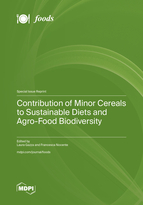Contribution of Minor Cereals to Sustainable Diets and Agro-Food Biodiversity
A special issue of Foods (ISSN 2304-8158). This special issue belongs to the section "Grain".
Deadline for manuscript submissions: closed (30 April 2023) | Viewed by 42458
Special Issue Editors
Interests: wheat; minor cereals; cereal quality; gluten; gluten intolerances; gluten-free; pasta; cereals processing; bioactive compounds; functional foods; plant biotechnology; breeding for quality
Special Issues, Collections and Topics in MDPI journals
Interests: wheat; cereal quality; pasta; cereals processing; cereal technology; bioactive compounds; functional foods; malt; beer; cereal pathology; vegetable milks
Special Issue Information
Dear Colleagues,
Increased awareness of the nutritional properties of foods and recent trends towards low-input and sustainable agriculture have led to a renewed interest in underutilized crops. In addition, the dependence on a small number of crop species limits the capability to cope with challenges posed by the adverse effects of climate change affecting food security. One solution could be the wider use of the so-called orphan or minor cereals to diversify agricultural systems and food sources. Beyond being highly nutritious, underutilized cereals are inherently resilient, making them a suitable surrogate to major ones such as wheat, rice and corn. In addition, many cereals considered neglected at a global level are staples at a national or regional level.
This Special Issue deals with the continuum aspects, ‘from farm to fork’, in terms of ways that minor cereals could boost food security, foster rural development, support sustainable land care and contribute to healthier diets. In this Special Issue, we aim to publish innovative research and review papers about the rediscovery of minor cereals, their technological, biochemical and nutritional characteristics, and test their attitude for the formulation of innovative wholegrain, low or gluten-free products which will meet the need of health-conscious consumers so as to encourage the use of niche cereals. New raw materials, new functional ingredients, upcycling of waste materials and in vivo experiments to test the effect of assumption of these cereals will be further addressed in this Special Issue. Predictions of product quality, adopting chemometrics, multi-variate and statistical data analysis approaches are also welcome.
In conclusion, this Special Issue aims to provide fundamental understanding and the current strategies for revitalization of underutilized cereals, which represent a reservoir of biodiversity that is useful to ensure sustainable production in the context of climate change.
Dr. Laura Gazza
Dr. Francesca Nocente
Guest Editors
Manuscript Submission Information
Manuscripts should be submitted online at www.mdpi.com by registering and logging in to this website. Once you are registered, click here to go to the submission form. Manuscripts can be submitted until the deadline. All submissions that pass pre-check are peer-reviewed. Accepted papers will be published continuously in the journal (as soon as accepted) and will be listed together on the special issue website. Research articles, review articles as well as short communications are invited. For planned papers, a title and short abstract (about 100 words) can be sent to the Editorial Office for announcement on this website.
Submitted manuscripts should not have been published previously, nor be under consideration for publication elsewhere (except conference proceedings papers). All manuscripts are thoroughly refereed through a single-blind peer-review process. A guide for authors and other relevant information for submission of manuscripts is available on the Instructions for Authors page. Foods is an international peer-reviewed open access semimonthly journal published by MDPI.
Please visit the Instructions for Authors page before submitting a manuscript. The Article Processing Charge (APC) for publication in this open access journal is 2900 CHF (Swiss Francs). Submitted papers should be well formatted and use good English. Authors may use MDPI's English editing service prior to publication or during author revisions.
Keywords
- einkorn
- emmer
- spelt
- oats
- sorghum
- millets
- teff
- tritordeum
- triticale
- ancient cereal species
- wholemeal
- gluten free
- wheat sensitivity
- omics of minor cereals
- agro-food biodiversity
- sustainable diets








